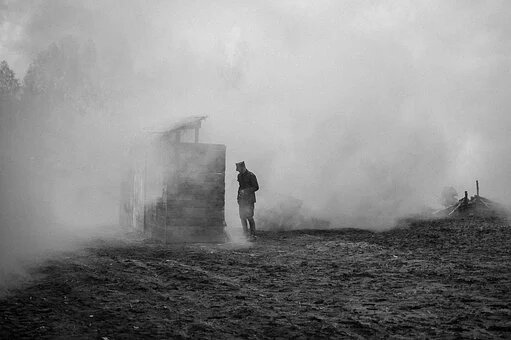
“Bullet in the Brain” by Tobias Wolff is a short story that follows the life of Anders, a jaded book critic, who unexpectedly finds himself in a bank during a robbery. The narrative explores Anders’ final moments and reflects on his past experiences and attitudes toward life. “Bullet in the Brain” is known for its concise and powerful prose and its exploration of themes such as memory, mortality, and the unexpected nature of life.
Bullet in the Brain was first published in The New Yorker in 1995.
Bullet in the Brain | Summary
“Bullet in the Brain” by Tobias Wolff is a thought-provoking short story that delves into the final moments of a world-weary book critic named Anders. The narrative captures the essence of life’s unpredictability and the impact of our experiences. The story begins by introducing Anders, a middle-aged man renowned for his scathing criticism of books. As we delve into his character, it becomes apparent that he possesses a cynical and disillusioned outlook on life. His work has made him bitter and dismissive of mediocrity, constantly finding fault in the world around him.
One day, Anders finds himself in a bank during a robbery. While other customers are terrified, Anders appears almost indifferent, as if his apathy extends even to this life-threatening situation. As the robbers assert their dominance, their demands and threats fill the air, intertwining with the thoughts and observations running through Anders’ mind. In a sudden turn of events, Anders becomes a victim of a bullet to the brain. However, instead of experiencing a flurry of final memories or regrets, something unexpected occurs. As the bullet travels through his brain, time seems to stretch, allowing Anders’ mind to reminisce about his past.
Flashbacks transport us to different moments of Anders’ life. We witness snippets of his childhood, his early love for books, and the transformation of his passion into a critical lens that distorts his perception. These memories reveal the roots of his cynicism, shedding light on his attitude and demeanor. Amidst these memories, the story explores the power of language and literature. Anders, known for his sharp tongue, finds solace in books, which have shaped his identity and provided him with a form of escape. The irony lies in the fact that his final moments occur during a robbery, far removed from the world of words and stories he once cherished.
As the bullet inches closer to its fatal destination, the story poses profound questions about the brevity and fragility of life. It suggests that even the most cynical and detached individuals, like Anders, can experience moments of vulnerability and reflection. In his final seconds, he is stripped of his acerbic exterior, revealing a fleeting vulnerability that humanizes him. In the end, “Bullet in the Brain” challenges us to contemplate our own lives and the narratives we construct. It reminds us that even the most hardened souls have their own stories, scars, and intricate layers beneath the surface. The story’s concise prose and poignant exploration of memory and mortality make it a captivating piece of literature.
Bullet in the Brain | Analysis
The short tale “Bullet in the Brain” is both fascinating and thoughtful. Tobias Wolff’s character, Anders, provides a critical assessment of pessimism and its implications. Anders is the personification of despair and hatred. His employment has affected not only his perspective on literature but also on life itself. Wolff uses Anders as a vehicle to critique the dangers of unchecked cynicism, highlighting the potential for detachment and alienation from the world around us.
The robbery scene becomes a pivotal moment in the story, as it confronts Anders with a life-or-death situation. While other characters respond with fear and panic, Anders appears unfazed, almost bored. This reaction speaks to his deeply ingrained apathy, suggesting that his detachment extends even to moments of mortal danger. It prompts readers to reflect on the consequences of a life lived without emotional engagement.
Using flashbacks, Wolff provides glimpses into Anders’ past, revealing the roots of his cynicism. The story suggests that Anders’ outlook is not merely a result of his profession but also a product of his personal history. These flashbacks, intertwined with the present moment of the robbery, show how our past experiences shape our perceptions and influence our responses to critical situations.
The story’s structure is worth noting, as it presents a nonlinear narrative. The flashbacks disrupt the linear progression of time, allowing readers to experience Anders’ final moments while delving into his memories simultaneously. This technique adds depth to the story, exploring the complexity of human consciousness and the non-linearity of memory.
“Bullet in the Brain” raises questions about the brevity of life and the significance of our narratives. Anders’ abrupt and unexpected demise serves as a reminder of the fragility of existence, urging readers to contemplate their mortality and the stories they construct for themselves. It challenges us to reflect on the impact of our experiences on our worldview and the importance of finding meaning and connection amidst the fleeting moments of life.
Bullet in the Brain | Themes
The story explores the consequences of unchecked cynicism and emotional detachment. Through the character of Anders, the narrative portrays the dangers of becoming disconnected from the world around us.
The story delves into the power of memory and its influence on our perception of the world. Flashbacks allow readers to witness pivotal moments from Anders’ past, revealing how our personal experiences shape our attitudes and outlooks.
“Bullet in the Brain” highlights the brevity and fragility of human existence. Anders’ sudden demise during the robbery serves as a reminder of the fleeting nature of life and the unpredictability of its end.
The plot delves into the importance of language and narrative as ways of escape and meaning-making. Anders, who loved reading, also finds consolation in books. However, his job as a critic has changed his connection with words, causing a schism between his academic and emotional interests.
The narrative employs irony and unexpected twists to challenge assumptions and provoke reflection. The contrast between Anders’ final moments and his life as a book critic highlights the unpredictability of life and the irony of his ultimate demise in a situation devoid of the written word.
“Bullet in the Brain” encourages readers to reflect on their own lives and the narratives they construct. It prompts introspection about the impact of our experiences, attitudes, and outlooks on our perception of the world and our relationships with others.
Bullet in the Brain | Character Sketch
Anders, the central character in “Bullet in the Brain,” is a middle-aged book critic who embodies cynicism and detachment. He possesses a sharp intellect and a biting tongue, which he employs mercilessly in his critiques of literature.
Physically, Anders is described as middle-aged with thinning hair and glasses. His appearance suggests a certain weariness of the world, mirroring his cynical perspective. He carries himself with an air of aloofness and indifference, seemingly unaffected by the world around him. Anders’ cynicism is deeply rooted, stemming not only from his occupation but also from his personal history. The story provides glimpses into his past, revealing a childhood marked by a love for books and the power of storytelling. However, as he grew older, his passion transformed into a critical lens that distanced him from the emotional resonance of literature.
In his interactions with others, Anders often displays a condescending and dismissive demeanor. He uses his intelligence as a shield, relying on sarcasm and such remarks to maintain emotional distance. This detachment is further highlighted during the robbery scene, where he remains unfazed, almost bored, in the face of mortal danger.
Despite his caustic exterior, the story offers glimpses of vulnerability and humanity beneath Anders’ hardened façade. The flashbacks to his past reveal moments of innocence, curiosity, and a genuine love for language. These glimpses humanize him, reminding readers that even the most cynical individuals have complex inner lives and are susceptible to moments of reflection.
Anders’ fate in the story, struck by a bullet in the brain, adds an element of irony. In his final moments, the story strips away his detachment, allowing readers to glimpse the vulnerability that lies beneath his hardened exterior. This unexpected ending prompts contemplation of the complexities of human nature and the unpredictability of life.
Bullet in the Brain | Literary Devices
The story employs flashbacks to delve into Anders’ past, allowing readers to gain insight into his character and experiences. These shifts in time contribute to the narrative structure and provide a deeper understanding of the protagonist’s motivations and cynicism.
Irony is a recurring literary device in the story. It is particularly evident in the contrast between Anders’ occupation as a book critic and his ultimate demise. The irony highlights the unpredictability of life and challenges assumptions about the significance of intellectual pursuits.
Symbolism is employed to convey deeper meanings throughout the narrative. For example, the bullet that strikes Anders in the brain serves as a symbolic representation of the consequences of his cynicism and detachment. It becomes a catalyst for introspection and prompts reflection on the brevity of life.
The story utilizes vivid and evocative imagery to enhance the reader’s sensory experience. Descriptions such as “a brick-shaped bank” and “a scuffed-up kitchen chair” create visual imagery that adds realism to the scenes and helps to establish the story’s setting.
The dialogue in the story serves multiple purposes. It reveals aspects of the characters’ personalities, provides insights into their relationships, and contributes to the overall tension and atmosphere of the scenes. The dialogue also helps to convey the characters’ emotions and thoughts indirectly.
The story employs foreshadowing to hint at the tragic events that will unfold. The mention of Anders’ annoyance with mundane conversations and his dismissive attitude towards the robbery foreshadows the unexpected turn of events and the impact it will have on his life.
Allusions to literature and cultural references are scattered throughout the story. They provide additional layers of meaning and contribute to the exploration of the power of language and storytelling.




